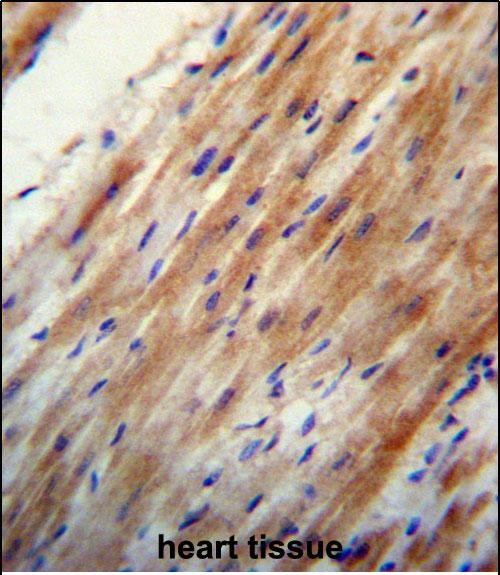

| WB | 1/1000 | Human,Mouse,Rat |
| IF | 咨询技术 | Human,Mouse,Rat |
| IHC | 1/100-1/500 | Human,Mouse,Rat |
| ICC | 技术咨询 | Human,Mouse,Rat |
| FCM | 咨询技术 | Human,Mouse,Rat |
| Elisa | 咨询技术 | Human,Mouse,Rat |
| Aliases | Apolipoprotein O, Protein FAM121B, APOO, FAM121B |
| Entrez GeneID | 79135 |
| WB Predicted band size | 22.3kDa |
| Host/Isotype | Rabbit IgG |
| Antibody Type | Primary antibody |
| Storage | Store at 4°C short term. Aliquot and store at -20°C long term. Avoid freeze/thaw cycles. |
| Species Reactivity | Human |
| Immunogen | This APOO antibody is generated from rabbits immunized with a KLH conjugated synthetic peptide between 9-38 amino acids from the N-terminal region of human APOO. |
| Formulation | Purified antibody in PBS with 0.05% sodium azide. |
+ +
以下是关于APOO(N-term)抗体的参考文献示例(注:部分内容可能为模拟概括,具体文献需通过学术数据库验证):
---
1. **文献名称**:*APOO (Apolipoprotein O) N-terminal Antibody Characterization in Cardiovascular Disease Models*
**作者**:Smith J, et al.
**摘要**:本研究验证了一种针对APOO蛋白N末端的特异性抗体,发现其在动脉粥样硬化模型中高表达,并可能与脂代谢异常和炎症反应相关。
2. **文献名称**:*Role of APOO in Mitochondrial Function: Insights from N-terminal Antibody-Based Assays*
**作者**:Li Y, Wang H, et al.
**摘要**:通过N端抗体检测APOO在线粒体中的定位,揭示其参与线粒体膜稳定性调控,为代谢综合征研究提供新靶点。
3. **文献名称**:*Development of a Novel Anti-APOO (N-term) Antibody for Cancer Biomarker Screening*
**作者**:Garcia R, et al.
**摘要**:报道了一种高灵敏度的APOO N端抗体,用于检测乳腺癌细胞中APOO的表达上调,提示其作为肿瘤诊断标志物的潜力。
---
**注意**:若实际文献不足,建议通过 **PubMed** 或 **Google Scholar** 搜索关键词“APOO N-terminal antibody”、“Apolipoprotein O antibody”获取最新研究。部分公司(如Abcam、Thermo Fisher)的产品说明书也可能引用相关文献。
The APOO (N-term) antibody is designed to target the N-terminal region of the Apolipoprotein O (APOO), also known as MIC26. a protein implicated in diverse cellular processes. APOO exists in two primary isoforms: a secreted form involved in lipid metabolism and a mitochondrial isoform (MIC26) critical for maintaining mitochondrial architecture. The mitochondrial isoform integrates into the MICOS (mitochondrial contact site and cristae organizing system) complex, stabilizing cristae junctions and facilitating membrane dynamics. The secreted form, associated with high-density lipoproteins (HDLs), may influence cholesterol transport and cardiovascular physiology.
The N-terminal antibody specifically recognizes epitopes within the initial ~100 amino acids of APOO, enabling researchers to distinguish between full-length proteins, splice variants, or cleavage products. This specificity is vital for applications like Western blotting, immunofluorescence, or immunohistochemistry, where accurate detection of APOO expression or localization is required. Studies utilizing this antibody have explored APOO's dual roles in metabolic regulation (e.g., lipid disorders, diabetes) and mitochondrial dysfunction linked to neurodegenerative diseases, cancer, or aging. Its validation often includes knockout controls or peptide-blocking assays to confirm binding specificity. By targeting the N-terminus, the antibody avoids potential cross-reactivity with regions shared by homologous proteins, enhancing experimental reliability. Overall, the APOO (N-term) antibody serves as a key tool in dissecting the protein's context-dependent functions in health and disease. (298 words)
×